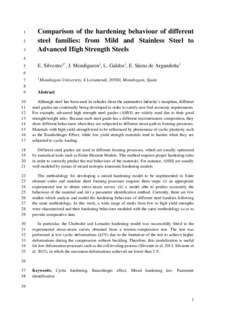Título
Comparison of the hardening behaviour of different steel families : from mild and stainless steel to advanced high strength steelsFecha de publicación
2015Versión
PostprintTipo de documento
ArtículoArtículoIdioma
InglésDerechos
© 2015 Elsevier Ltd. All rights reservedAcceso
Acceso abiertoVersión de la editorial
https://doi.org/10.1016/j.ijmecsci.2015.07.013Publicado en
International Journal of Mechanical Sciences Vol. 101–102. Pp. 10–20. October, 2015Editorial
Elsevier Ltd.Palabras clave
Cyclic hardeningBauschinger Effec
Mixed hardening law
Parameter identification
Resumen
Although steel has been used in vehicles from the automotive industry's inception, different steel gradesare continually being developed in order to satisfy new fuel economy requirements. For example, ... [+]
Although steel has been used in vehicles from the automotive industry's inception, different steel gradesare continually being developed in order to satisfy new fuel economy requirements. For example,advanced high strength steel grades (AHSS) are widely used due to their good strength/weight ratio.Because each steel grade has a different microstructure composition, they show different behaviourswhen they are subjected to different strain paths in forming processes. Materials with high yieldstrength tend to be influenced by phenomena of cyclic plasticity such as the Bauschinger Effect, whilelow yield strength materials tend to harden when they are subjected to cyclic loading.Different steel grades are used in different forming processes, which are usually optimised bynumerical tools such as Finite Element Models. This method requires proper hardening rules in order tocorrectly predict the real behaviour of the materials. For instance, AHSS are usually well modelled bymeans of mixed isotropic–kinematic hardening models.The methodology for developing a mixed hardening model to be implemented infinite elementcodes and simulate sheet forming processes requires three steps: (i) an appropriate experimental test toobtain stress–strain curves, (ii) a model able to predict accurately the behaviour of the material and (iii) aparameter identification method. Currently, there are few studies which analyse and model thehardening behaviour of different steel families following the same methodology. In this work, a widerange of steels from low to high yield strengths were characterised and their hardening behaviourmodelled with the same methodology so as to provide comparative data.In particular, the Chaboche and Lemaitre hardening model was successfullyfitted to the experi-mental stress–strain curves obtained from a tension–compression test. The test was performed at lowcyclic deformations (72%) due to the limitation of the test to achieve higher deformations during thecompression without buckling. Therefore, this modelization is useful for low deformation processes suchas the roll levelling process (Silvestre; 2013, Silvestre et al.Steel Res Int; 2012, 1295), in which themaximum deformations achieved are lower than 2%. [-]
Sponsorship
Gobierno de EspañaID Proyecto
Ministerio de Ciencia e Innovación. Plan Nacional de I+D+i 2008-2011. Programa Nacional de cooperación Público-Privada. Subprograma INNPACTOColecciones
- Artículos - Ingeniería [758]





















